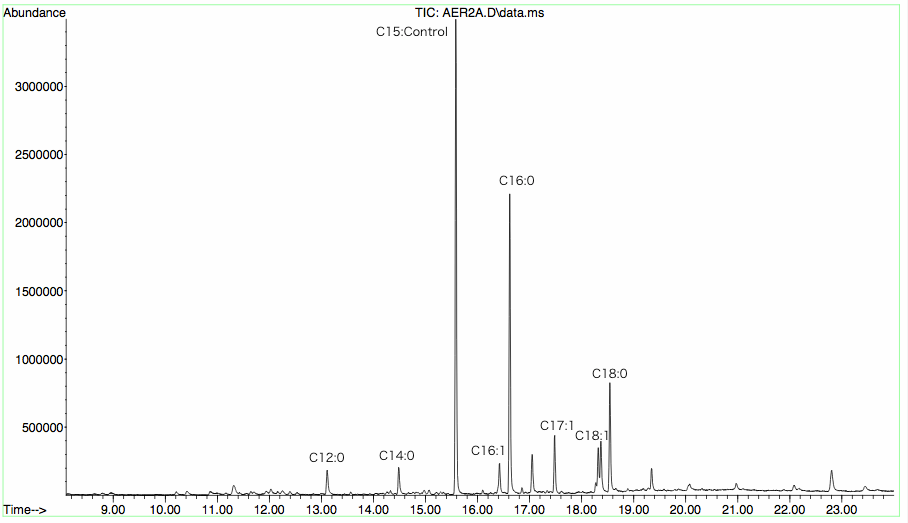Part:BBa_K771306
FabG with Membrane Anchor 3
BBa_K771306:FabG is linked to C terminal of BBa K771003 by Flexible Linker 3(FL3).
Fatty acid Biosynthetic Pathway
TesA involves in the biosynthesis of fatty acids in E.coli. The biosynthesis pathway is shown as below:
The E. coli fatty acid synthesis is initiated when holo-ACP, NADPH and NADH, acetyl-CoA and malonyl-CoA undergo condensation and subsequent reduction to form butyryl-ACP. These reactions are catalyzed by the malonyl-CoA:ACP transacylase FabD, the ketosynthase FabH, the NADPH-dependent ketoreductase FabG, either the dual-function dehydratase/isomerase FabA or the monofunctional dehydratase FabZ, and the NADH-dependent enoyl reductase FabI. Then the butyryl-ACP is extended via 5-7 rounds of analogous reactions to produce a C14 to C18-ACP either fully saturated or monounsaturated. These extension cycles are catalyzed by either the ketosynthase FabB or FabF in collaboration with FabD, FabG, FabA or FabZ, and FabI. Finally, the full-length fatty acid is released from the corresponding fatty acyl-ACP via hydrolysis by C16-specific thioesterase,TesA.
The cooperation of enzymes with membrane anchors
TesA with Membrane Anchor 2 (without MS2), FabG with Membrane Anchor 3, FabZ with Membrane Anchor 4, FabI with Membrane Anchor 4(without VVD) could significantly enhance the production of fatty acid by 9 fold compared with enzymes without membrane anchor.
To optimize the productivity of the system we established, we tended to combine these two privileges together, gathering TesA, FabG, FabI and FabZ through receptor-ligand interaction. Notable increase in both diversity and amount of fatty acids were detected.
Cluster of FabG, FabI and FabZ provides C16- and C18 specific TesA with sufficient amount of fatty acyl-ACP to hydrolyze and release. Therefore, we witnessed a tremendous growth in the turnover of fatty acids with C16 and C18 skeleton in the supernatant.(Fig.2 A)
Moreover, fatty acids with C14 skeleton was first detected in E.coli expressing membrane anchored enzymes compared with ones with free enzymes. It is probably because the productivity of cluster of FabG, FabI and FabZ overloads itself when carbon chain growth slows down as it elongates. Monounsaturated fatty acids also emerge in considerable amount for the first time since TesA is located so closely to the cluster of FabG, FabI and FabZ that it catches intermediate with C16 and C18 skeleton even before they are reduced.(Fig.2 C)
Augment in both diversity and amount of fatty acids led to 24 fold increase in total yield compared with wild type and 9 fold with ones expressing free enzymes. (Fig.2 B) The exciting result convincingly proves that membrane enhances receptor-ligand interaction and cluster of enzymes makes it faster to a surprising extent. Products acclumulates near inner membrane and traval a shorter distance to diffuse through membrane.
Protocols
- Transfer a fresh transformed colony to 5ml LB liquid medium and shake at 37℃ overnight(12h).
- Add seed broth to 50ml LB medium(volume ratio is 3% and loaded liquid is 20%) and shake until the OD600 reaches 0.6 or so. Add inducer of appropriate concentration to induce gene expression.
- Continue shake culture for another 20h. Contrifuge at 8,000 for 5min. Collect supernatant and bacteria sediment respectively (prepare 3 parallel samples, each 10ml).
- Extract the supernatant by chloroform-methanol(2:1) solution of the same volume (shake for 5min) place until stratification. Dry the lower organic layer at 50℃ for about 24h. Suspend the bacteria by 1ml ddH2O. Add 20ml chloroform-methanol solution and extract for another 2 times.(Attention: weigh the empty flask before drying).
- Weigh the crude extract and record the results.
- Dissolve the crude extract with 1ml methanol and add 2ml tetrafluoroboron. Methyl esterificate at 60℃ for 30min. After the reagent cools down, add 2ml N-hexane and extract for 2 times. Collect the upper layer and dry overnight at 50℃ .
- Add the crude bacteria extract to 1ml chloroform-methanol(2:1) solution and shake by vortex to extract the total lipid of the cells. Add 2ml methanol-water(4:1) as saponification reagent. Saponificate in 60℃ water bath for 1h. Then esterificate as the 6th step.
- Dissolve the obtained fatty acidmethyl ester(FAME)mixture with N-hexane. Take 1ml sample for test.
- GC-MS condition:
Sample injector temperature: 250℃; Detector temperature: 280℃; Temperature programming: begin at 100℃ and last 2min. Warm to 250℃ at the rate of 10℃/min and last 5min. Use C15 FAME as the interior label for quantification. (Quantity of C15 FAME depends on the sample concentration)
GC-MS Result
The cooperation of enzymes with membrane anchors
<br\><br\><br\><br\><br\>
Sequence and Features
- 10COMPATIBLE WITH RFC[10]
- 12COMPATIBLE WITH RFC[12]
- 21COMPATIBLE WITH RFC[21]
- 23COMPATIBLE WITH RFC[23]
- 25INCOMPATIBLE WITH RFC[25]Illegal AgeI site found at 904
Illegal AgeI site found at 1192 - 1000INCOMPATIBLE WITH RFC[1000]Illegal BsaI site found at 525
| n/a | FabG with Membrane Anchor 3 |





